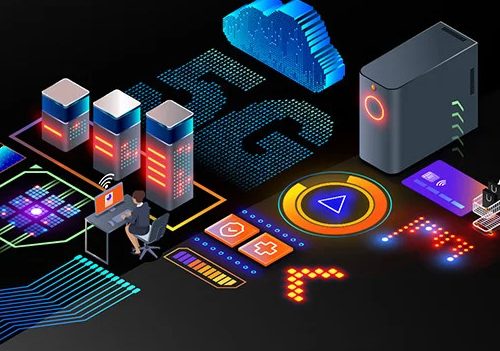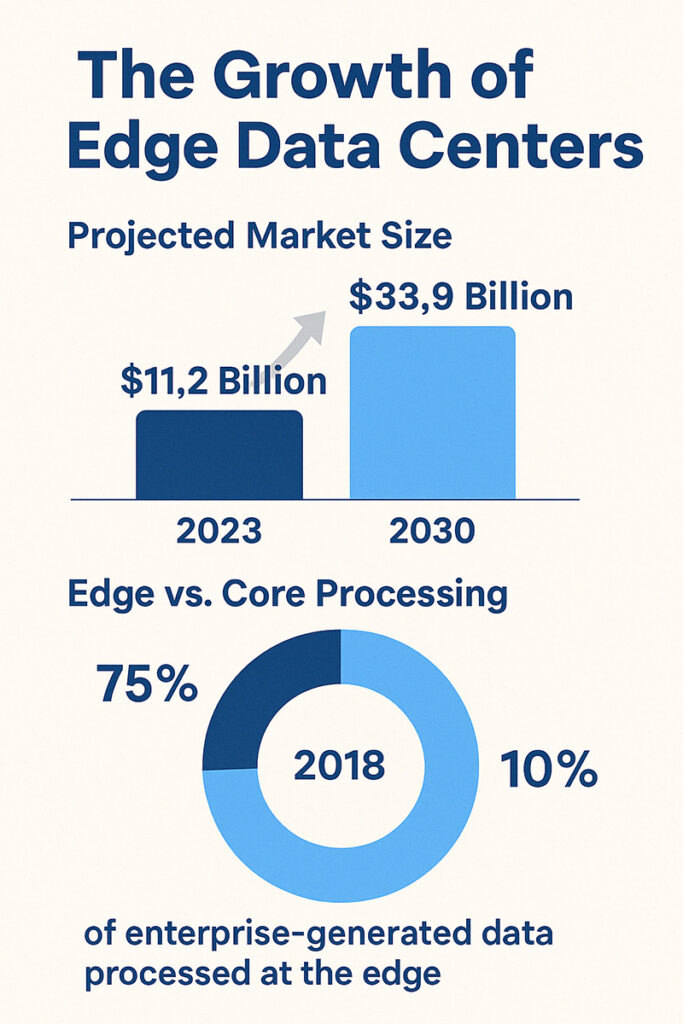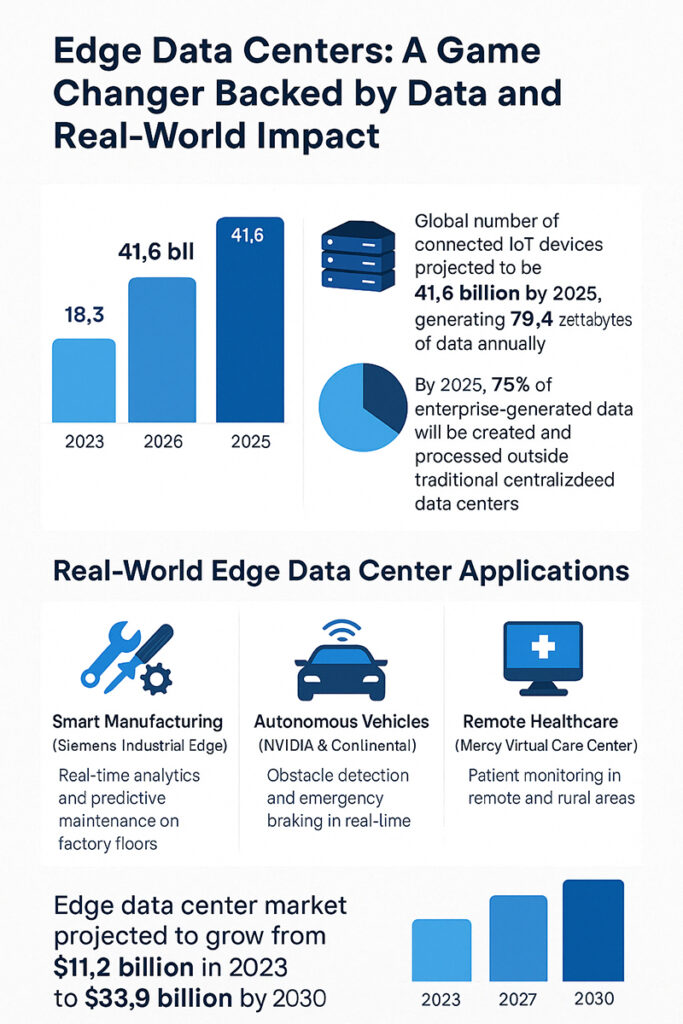Edge Data Centers and IoT: The Future of Real-Time Data Processing

Edge Data Centers: A Game Changer Backed by Data
As the volume of connected devices continues to surge, edge data centers are no longer just an innovation—they are a necessity. According to IDC, the global number of connected IoT devices is projected to reach 41.6 billion by 2025, generating over 79.4 zettabytes (ZB) of data annually. Traditional centralized data center models struggle to meet the demand for real-time responsiveness and localized processing that these applications require.
Edge data centers bridge this gap by bringing compute and storage capabilities closer to where data is generated—whether that’s a smart manufacturing floor, a traffic camera, or a wearable health monitor. This localized processing significantly reduces latency, enhances reliability, and relieves core network congestion.
The rollout of 5G further amplifies the role of edge infrastructure. With its ultra-low latency and high bandwidth, 5G unlocks use cases such as autonomous vehicles, telemedicine, and real-time industrial control—all of which depend on rapid data turnaround. Gartner predicts that by 2025, 75% of enterprise-generated data will be created and processed outside traditional centralized data centers, up from just 10% in 2018.
Investment trends reflect this shift. MarketsandMarkets estimates the edge data center market will grow from USD 11.2 billion in 2023 to USD 33.9 billion by 2030, driven by the demand for intelligent, location-sensitive computing solutions. Organizations deploying edge infrastructure report gains in operational efficiency, reduced downtime, and enhanced service delivery, particularly in remote or bandwidth-limited locations.
At AKCP, we recognize the strategic importance of edge computing. Our monitoring solutions are built to support distributed architectures, providing real-time insights into power, environment, and security parameters — crucial for maintaining uptime and performance at the edge.

Edge Data Centers: Efficiency in Action
Edge data centers operate on a similar principle. When end-users request data, it’s swiftly delivered from a nearby edge center, bypassing the need to traverse to a distant centralized data center. Furthermore, the interconnected nature of edge centers, akin to a mesh-like structure, enhances data delivery capabilities. The key takeaway is that end-users require data centers within a 10-millisecond proximity to optimize throughput for their diverse devices.
Key Characteristics of an Edge Data Center
- Close Proximity to Users: The primary aim is to reduce latency and boost throughput, achieved through physical proximity to end-users, minimizing network roundtrip time.
- Part of a Larger Network: Edge data centers are seldom standalone entities. They often function within a broader network framework, sometimes utilizing a “hub-and-spoke” model. Multiple edge data centers might span larger geographic areas.
- Fast Processing Power: In addition to low latency, these centers boast rapid processing capabilities to ensure swift fulfillment of end-users’ requests.
- Space Efficiency: Edge data centers are typically compact to facilitate placement in various locations. The size varies depending on specific applications and proximity requirements.
- Easy Maintenance: Due to their distributed nature, maintaining edge data centers differs from traditional data centers. These sites must be designed with maintenance and supply chain considerations in mind, given the stringent latency demands of most edge computing applications.
Benefits of Embracing Edge Data Centers
Implementing an edge data center network can deliver numerous benefits to consumers:
1. Faster Service and Increased Bandwidth
Data is serviced more swiftly compared to larger remote data centers, as it travels shorter distances and passes through fewer network components. Edge data centers typically process smaller portions of a network’s data, resulting in faster computations.
2. Enhanced Network Resilience
Traditional centralized data centers, whether multi-tenant or enterprise-focused, are susceptible to costly downtimes and service interruptions. Edge data centers offer a mesh coverage, where the downtime of one center is mitigated by others. This resilience benefits both end-users and edge applications.
3. Cost-Effectiveness
Edge systems demand less hardware and maintenance than their centralized counterparts, tailored to specific workflow needs. This cost efficiency allows for scalable network expansion to meet growing demands.
4. Customizability
The modular design of edge data centers not only saves costs but also enables precise customization based on intended use. For instance, an IoT device analyzing images may require more GPUs than CPUs, a configuration uncommon in traditional data centers.
5. Scalability
The network can effortlessly scale based on demand by adding small, flexible edge data centers. The system’s architecture, designed for distributed systems, remains largely unchanged while accommodating additional data center units as needed.

Industry Migration to the Edge
1. Smart Manufacturing – Siemens Industrial Edge
Example: Siemens has deployed edge data centers in smart factories to enable real-time data processing directly on the factory floor.
Impact: These edge deployments help reduce latency in critical control systems, support predictive maintenance, and ensure uptime by processing sensor data locally instead of relying on a centralized cloud.
Why It Matters: Manufacturing environments require millisecond response times—something that cloud-based processing often can’t guarantee. Edge computing allows factories to operate with greater automation and efficiency.
2. Autonomous Vehicles – NVIDIA & Continental
Example: NVIDIA partnered with Continental to develop an AI-powered edge platform that processes driving data locally in vehicles.
Impact: This edge architecture enables real-time decision-making (e.g., obstacle detection, braking) without needing to send data to the cloud—a must for road safety.
Why It Matters: Autonomous driving systems generate terabytes of data daily. Edge data centers embedded within vehicles handle this in real-time, reducing latency and ensuring reliability even in low-connectivity areas.
3. Remote Healthcare – Mercy Virtual Care Center
Example: Mercy’s Virtual Care Center in the U.S. leverages edge infrastructure to monitor patients in remote and rural areas in real-time.
Impact: Vital signs and patient metrics are processed locally at edge nodes, allowing doctors to intervene immediately when necessary.
Why It Matters: In areas with limited bandwidth or unstable connections, edge computing ensures continuity of care and immediate response in emergency scenarios.
